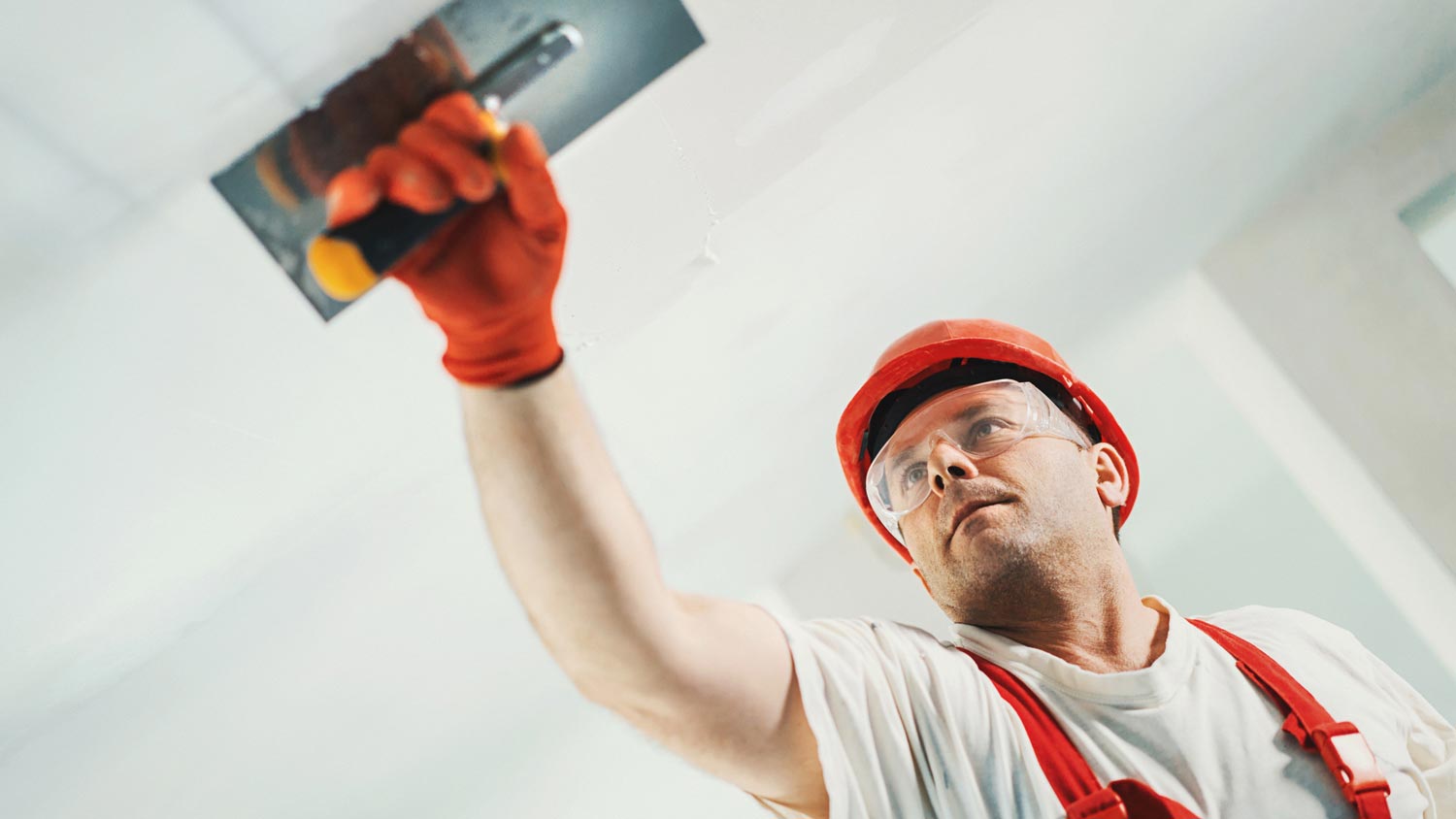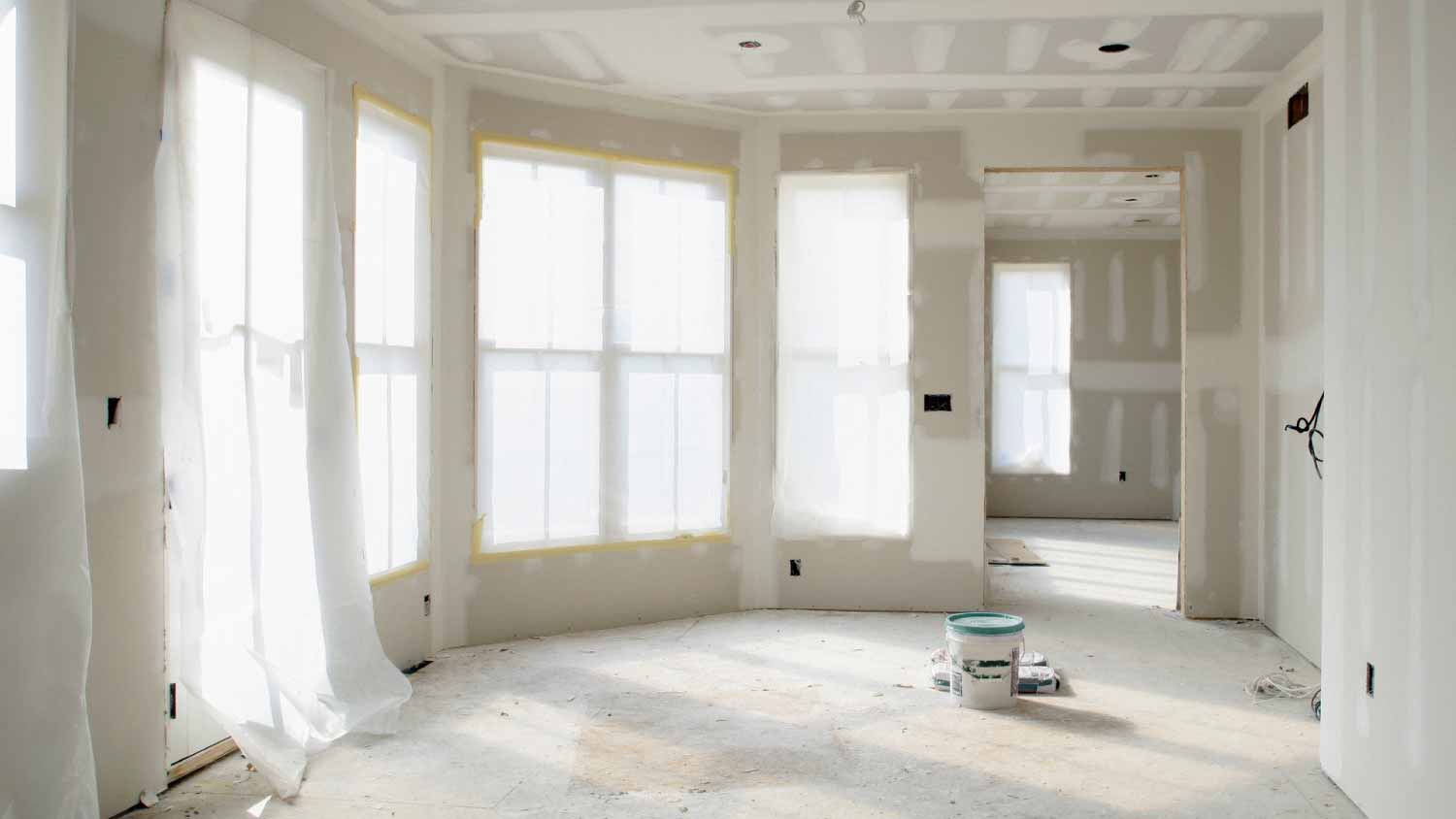
Skim coating drywall is a great alternative to replacement, and is often more affordable. Use this guide to estimate the cost to skim coat walls in your home.
DIY to a gorgeous interior update


Mudding drywall, also called taping or finishing drywall, gives your walls the smooth finish they need for adding paint or wallpaper. And it happens to be a fairly simple DIY project that most homeowners can complete themselves over a weekend. Learn all about how to mud drywall yourself while avoiding common drywall problems.
Crystalline silica is a toxic dust that's often generated during drywall installation, which can cause respiratory issues if exposed over time. A professional drywall installation company has the right tools to protect your home and ensure safe air quality after your project is completed.
Drywall "mud" is a gypsum-based paste that you can use to strengthen and smooth the joint and screw indentations that occur after hanging drywall. "Mudding" drywall involves applying multiple coats of mud to these indentations so that they're flush with the wall and no longer noticeable.
There are two primary types of drywall mud: pre-mixed and powdered. Choose the mud that makes the most sense for your project.
Pre-mixed drywall mud has already been mixed with water before you buy it. In general, it's a ready-to-apply mud with a smooth consistency. But there are several different types of pre-mixed mud, and the best type for your project depends on the result you want.
Topping mud: Topping mud is used as a finishing drywall coat. It's not as adhesive as all-purpose mud, so you shouldn't use it for first or second coats, but it's great for providing a smooth final finish before painting.
All-purpose mud: You can use all-purpose mud for virtually any mudding project, making it a great option for anyone who's new to drywall mudding. It offers a smooth finish and usually dries within a few hours, depending on your climate.
Lightweight all-purpose mud: After applying a coat of all-purpose mud, you can apply lightweight all-purpose mud for your second and third coats. This mud is thinner than standard all-purpose mud, so it can provide an even smoother finish.
Powered drywall mud—often called hot mud—comes as, well, a powder. So what is hot drywall mud and why would you use it? It is simply a type of finishing material that dries faster than regular mud, such as pre-mixed mud.
You must mix it with water to create the mudding paste. It hardens quickly—usually within 5 to 20 minutes, depending on the type—so it's best used as a quick pre-filler for large holes or to smooth crushed drywall before you begin the mudding process.
When learning how to tape and mud drywall, you can pick among four different types of drywall tape, depending on your specific needs.
Paper: Paper tape is the most common and affordable option. It’s a highly durable type of paper, helping to strengthen the seams between drywall sheets while resisting tears. It does not have its own adhesive, so you must secure it in place with mud underneath.
Metal-reinforced paper: Some paper tape has a metal reinforced strip that allows it to precisely hold its shape when used on corners. Exposed corners on the drywall can suffer damage over time, but the metal reinforcement protects the drywall.
Vinyl-paper composite: Some drywall tape consists of a mixture of vinyl and paper. It’s usually best for odd-angled areas. However, it’s very expensive and it may pull loose from the wall in a room that has significant changes in humidity or temperature levels.
Fiberglass mesh: When you need significant strength from the tape, fiberglass mesh is the best choice. It’s more commonly used than all other drywall tapes, except for paper. When comparing paper versus mesh drywall tape, the mesh tape has an adhesive on the back, simplifying installation. It is mold-resistant, so drywallers often use it in bathrooms. However, it’s not as long-lasting or affordable as paper tape.
Drywall mudding is a messy business, so before you get started, protect your floor with a canvas drop cloth. It's best to use canvas rather than plastic because drywall mud can make plastic slippery.
After protecting your floors, protect yourself with a pair of safety goggles—the mud will sting if it gets into your eyes. You'll also want to wear clothing that you don't mind getting dirty or possibly ruining.

If you're using pre-mixed drywall mud, skip this step. If not, this is when you should mix your powdered drywall with water to create the mud. You can mix most drywall using a paddle bit on your power drill and beating the mud until it's smooth. But check the mud manufacturer's instructions to make sure it doesn't require any additional steps.
Now that your drywall is mixed and ready to go, it's time to apply the first coat. Grab your 6-inch taping knife and apply the mud to any screw indentations, as well as the joints, also known as seams, between your drywall panels. The joints typically form a two-inch indent—apply enough mud to completely fill the indentation, working it with your knife until it's evenly filled, then wiping away the remaining mud.
Once you fill the joint, cover it entirely with a piece of paper tape while it's still wet. You can use your taping knife to smooth it out and remove any bubbles.

Next, use your drywall knife to apply a thin coat of mud to both sides of the inside corners of your wall, taking care to fill the seams completely, including where both meet at the center. Then measure, cut, and pre-crease your paper tape so that it fits the seams you just mudded. Apply the tape over both sides of each inside corner, smoothing it with your taping knife.
If you have structural drywall corners that you need to apply to your outside corners, now is the time to apply them. Application methods vary, so check with the manufacturer for application instructions. After you apply a structural drywall corner to an outside corner, use your drywall knife to smooth mud over it to create a clean, sharp corner.
Once you mud the joints and corners with a first coat, let it dry—the drying process typically takes a few hours, depending on your climate. After it's dry, apply a second coat of mud to the joints, screw indentations, and inside and outside corners. You'll do this in the exact same way you applied the first coat, minus the taping (which is only necessary during the first coat).

After letting your second coat dry, apply a third (and final!) coat of mud. For this step, it's best to use a 10-inch drywall knife rather than a 6-inch knife because the wider edge will make it easier to create a thin, smooth application.

When the third and final coat is dry, you should sand it down to create a polished finish. Before beginning, protect your eyes and lungs by putting on a respirator mask and goggles. Then use a drywall pole sander to smooth all of the areas to which you applied drywall. Once this step is done, you're ready to paint or add wallpaper!
Your finished drywall will look more polished if you avoid these common drywall taping mistakes.
Using the wrong tools: Manual taping is slow, difficult work that can be hard to get right. Use an automatic taper to speed up the process, along with a set of drywall knives with various widths. Use small knives (6 inches wide) to smooth ridges and bumps. Opt for a wide knife (12 to 16 inches) when spreading the final coat of drywall mud.
Starting in the middle of the wall: Begin taping and mudding at the corners, then work toward the middle of the wall. Corners take the longest to dry and are the most challenging. Handle them first when you have the most energy and focus.
Too much pressure: Avoid using too much pressure when applying mud because it can shift or tear the tape. Aim for gentle, precise taping.
Too much compound: Instead of one or two thick coats of compound, layer the compound in thin, even layers. Using too much compound at once can lead to bulky, uneven drywall.
Wrong mud consistency: Thick mud causes bumpiness, and runny mud causes drips. Aim for a drywall mud consistency that’s similar to yogurt for the strongest, smoothest application.
Overlapping drywall tape: Apply drywall tape in a single layer to avoid bulges and unevenness. Cut your tape when doing joints to avoid any overlap.
Skipping corner beads on exterior corners: If your drywall creates an exterior corner, use a corner bead for structural support.
Not feathering joints: Gradually thin out your compound to blend in with the wall for an even finish.
Not protecting you and your home: Working with drywall involves exposure to dust—and that dust travels easily throughout your home and is very time-consuming to clean. Seal off your work area with plastic sheeting and cover any furniture. Wear protective gloves, goggles, and a dust mask.
Mudding drywall is a fairly straightforward project that most motivated DIYers can complete themselves. Having a pro install and mud drywall typically costs between $1 to $1.50 per linear foot. The total cost usually ranges from $476 to $575 for a standard project.
If you mud drywall yourself, you can skip these costs altogether. Instead, you'll only need to pay for the cost of drywall tools and supplies.
From average costs to expert advice, get all the answers you need to get your job done.

Skim coating drywall is a great alternative to replacement, and is often more affordable. Use this guide to estimate the cost to skim coat walls in your home.

Drywall texture can create an attractive finish and add dimension to your home’s walls. This guide breaks down the factors that influence the cost to texture drywall.

Whether you’re trying to keep noise in or out, soundproofing materials are the way to go. Use this guide to see how much it costs to soundproof a room.

Wondering if you can glue drywall instead of nailing it in place? Learn the pros and cons of drywall adhesive here. We’ve done the research for you.

What is joint compound? In short, it’s a specific type of filler made of gypsum dust—but of course, there’s much more to know. We’ve got you covered.

Hanging and finishing drywall can be hard work if you don’t have experience. These professional-level drywall mudding tips make the project easier.